PMB 4412 Exam 2
1/54
There's no tags or description
Looks like no tags are added yet.
Name | Mastery | Learn | Test | Matching | Spaced |
|---|
No study sessions yet.
55 Terms
two types of energy converting organelles
chloroplasts
plastids, found only in plants and algae
mitochondria
both are separated from the cytosol by a double membrane
characteristics of mitochondria and chloroplasts
semi-autonomous
divide by fission
contain circular chromosomal DNA, located in nucleoids within the stroma and matrix
contain ribosomes, tRNAs
depend on import of nuclear encoded proteins for many functions
generate transmembrane hydrogen gradient and use gradient to make ATP
overall formula for photosynthesis
6 CO2 + 6 H2O → C6H12O6 + 6O2
what happens during the light reactions of photosynthesis?
energy from light is used to phosphorylate ADP (produce ATP) and to reduce NADP+ to NADPH
in chloroplasts, the light reactions drive _______ of the thylakoid lumen
acidification
where is ATP generated in chloroplasts? where is ATP generated in mitochondria?
in chloroplasts = stroma
in mitochondria = matrix
A __________ can be formed when membranes allow selective permeation
diffusion potential
exists until chemical equilibrium is reached → then diffusion potential equals 0
diffusion is passive transport
what is the plant cell membrane potential inside relative to outside?
negative inside, positive outside
H+ ATPase pumps protons out
how does inhibiting ATP synthesis affect membrane potential?
membrane is depolarized
H+ ATPase pumps out protons, makes the inside of the membrane negative and the outside positive
turning off ATP synthesis mean means no more ATP hydrolysis, H+ ATPase becomes inactive
inside of the membrane becomes more positive
what forms of transport across membranes are passive?
diffusion
channels
uniporter: binds substrate on one side, changes conformation, releases substrate on other side
what forms of transport across membranes are active?
pump
symporter
antiporters
use energy to move something against its electrochemical gradient
molecular structure of H+ ATPase
both N and C terminus in cytoplasm
several transmembrane domains
transmembrane domains have occasional charged amino acids embedded in the membrane
these charged amino acids have special functions
regulatory domains within the cytoplasm
have bindings sites for Mg2+
phosphorylation domain
structure of H+ ATPase in vacuole membrane
domains in cytoplasm spin
channel allows proton flow from the cytoplasm to the lumen of the vacuole
hydrolyze ATP to move protons
process is reversible, based on stoich of protons to ATP
difference between H+ ATPase and ATP synthase
H+ ATPase hydrolyzes ATP to pump protons against their gradient
ATP synthase makes ATP using the power of protons moving down their gradient
structure of ATP
five carbon ribose sugar
adenine nitrogenous base
3 phosphates
3 phosphate linkage is unstable because negative charges are next to each other → hydrolysis
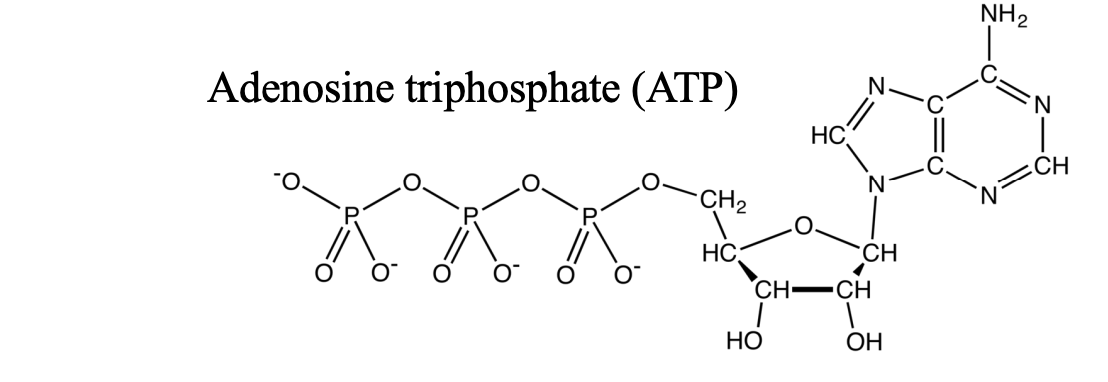
what are standard conditions?
25 degrees Celsius
1 M products and reactants
not cellular conditions
what is Keq?
concentration of products over concentration of reactants AT EQUILIBRIUM
when Keq is big = more products than reactants at equilibrium
when Keq is small = more reactants than products at equilibrium
ATP hydrolysis under standard conditions
ATP → ADP + Pi
Keq is large = ATP is unstable = wants to lose P
standard conditions are not cellular conditions

energy of ATP hydrolysis in the cell (no electrical component)
dependent on concentration of ATP and hydrolysis products

how do we consider just the electrical component of membrane potential?
energy required to transport one mole of charge against a membrane potential

how do we consider just the concentration component of membrane potential?
energy required to transport one mole of solute against a concentration gradient

what is equilibrium potential?
membrane potential at which the given ion concentrations are at equilibrium
how do we determine the equilibrium potential for a given ion?
Nernst potential
Walther Hermann Nernst
takes into account electrical and concentration components

graphing of equilibrium potentials
at zero, no net flux of the ion
slope of the line gives the conductance of the channels mediating the current
for cations
movement out of the cell = outward current = positive sign
movement into the cell = inward current = negative sign
for anions
movement out of the cell = negative sign
movement into the cell = positive sign

how do voltage-gated channels sense changes in voltage?
charged amino acids within the transmembrane spans sense changes in voltage of the membrane
channels change conformation in response to voltage changes
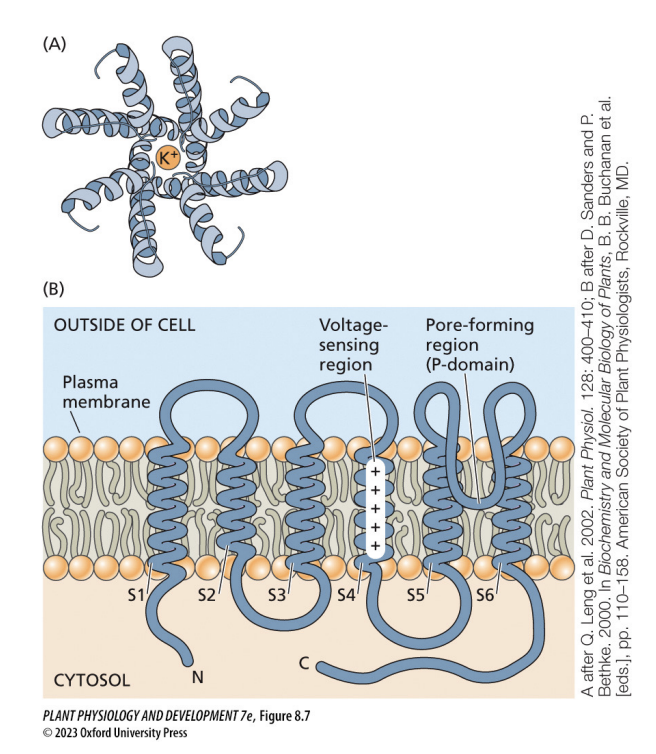
how can we use equilibrium potential graphs to determine what kind of channels ions are moving through?
outward channels open when membrane potential exceeds equilibrium potential for potassium → potassium moves out
inward channels open when membrane potential is below equilibrium potential for potassium → potassium moves in
“goal” = get the membrane potential as close to the ion equilibrium potential as possible
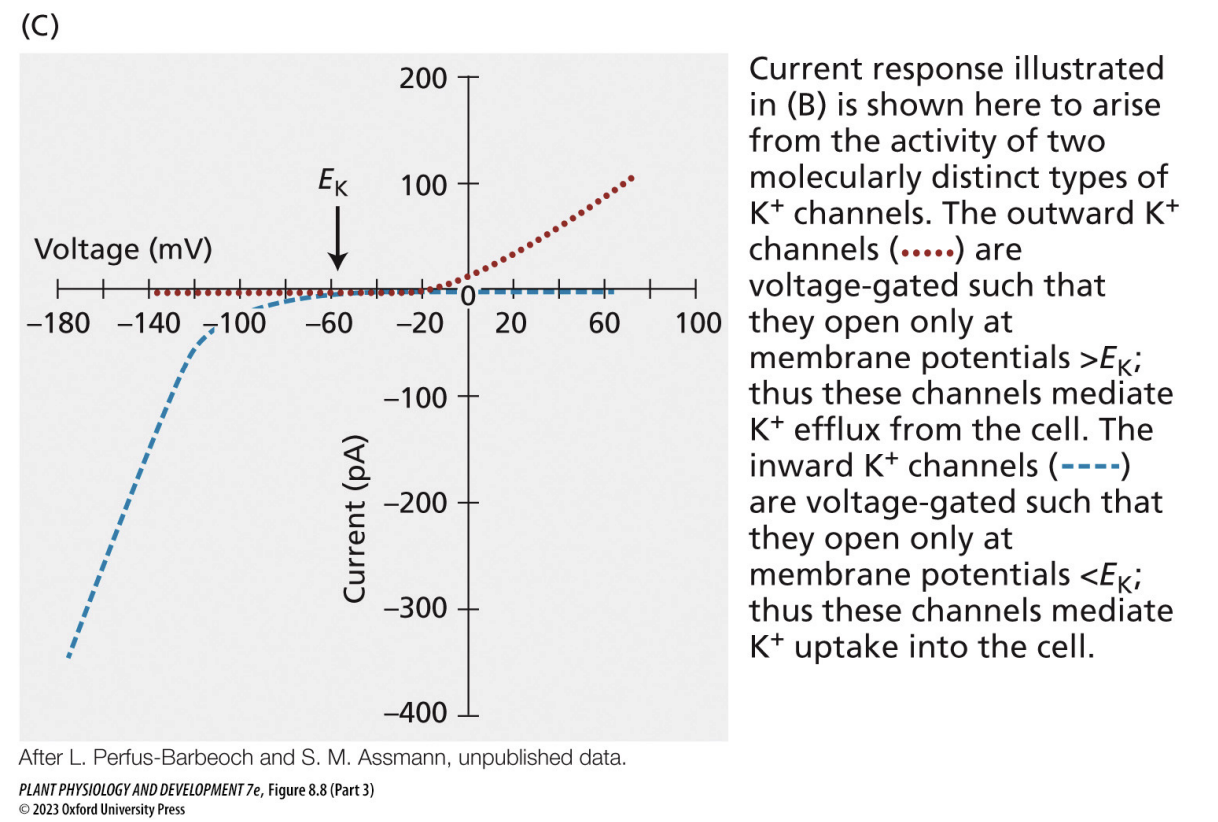
what is channel gating?
opening and closing of ion or solute channels
involves protein conformation change
once open, ions or solutes are conducted at very fast rates
what is voltage dependence?
regulation of the channel by membrane potential
open/close in response to voltage
how can we measure ion channels?
patch clamping
discovered by Erwin Neher and Bert Sakmann
electrophysiology methods
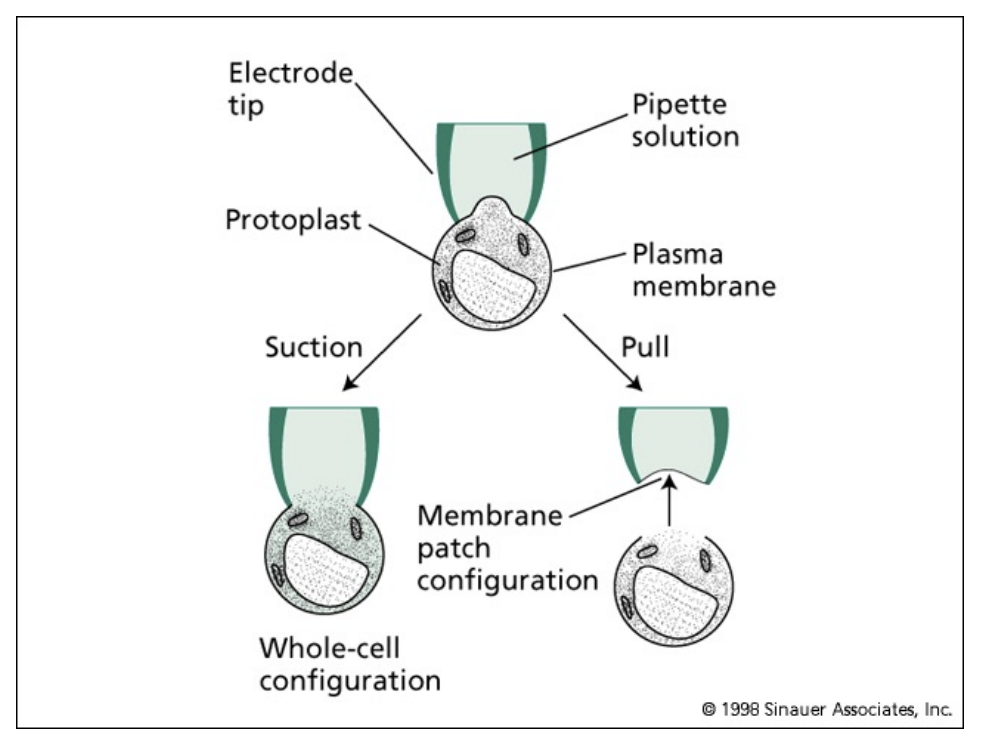
what is the first key reaction of photosynthesis?
splitting water
2 H2O → 4 e + 4 H+ + O2
O2 is a waste product
negative redox potential
what is redox potential mean?
negative redox potential = more willing to give up electrons
positive redox potential = more willing to take up electrons
electrons flow spontaneously from negative redox potentials to positive redox potentials
in the light reactions of photosynthesis, hydrogen is stockpiled into the __________, flows out the ATP synthase channel into the ________, and makes ATP in the __________
thylakoid lumen
stroma
stroma
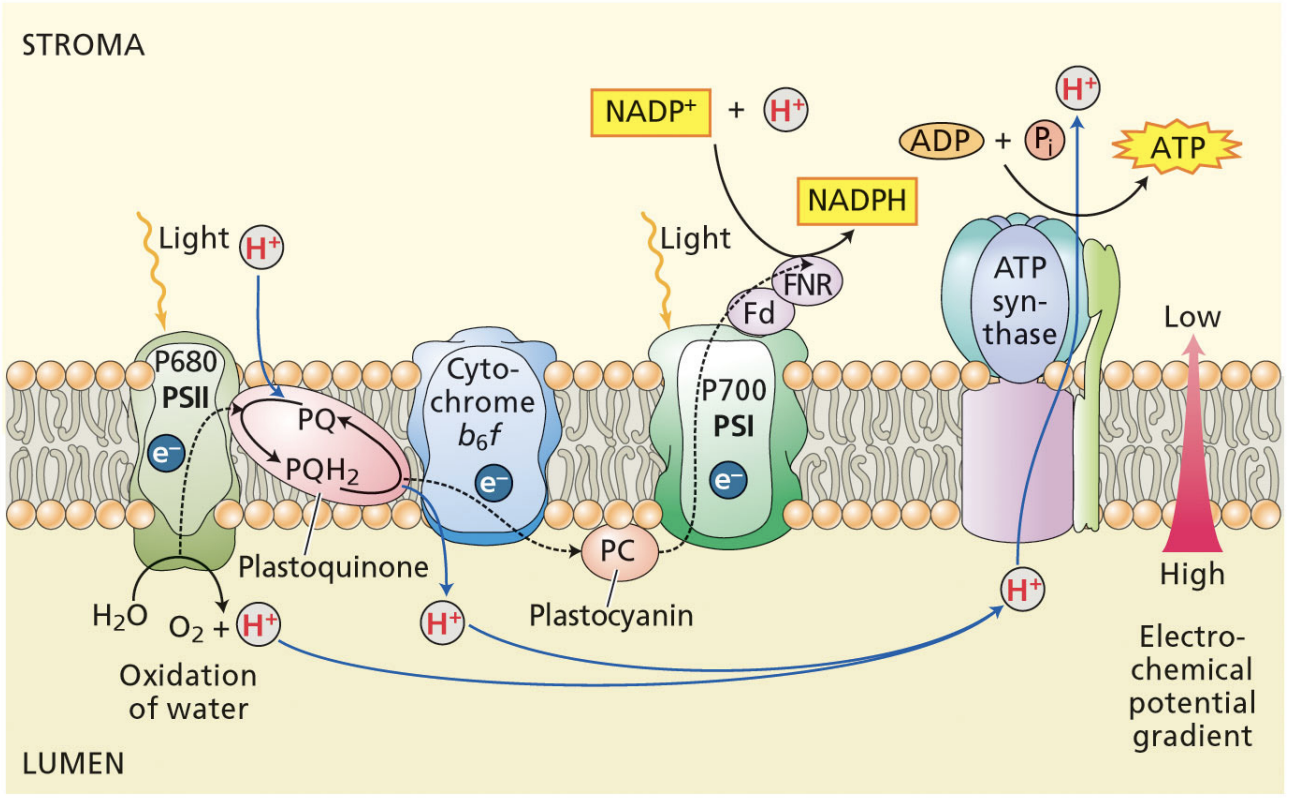
PSII is located primarily in the ________________
stacked grana
PSII
light oxidizes P680
P680 is reduced by the electrons from splitting H2O, protons from water are left in lumen
Reduced P680 passes electrons to a pheophytin (chlorophyll)
Pheophytin passes electrons to plastoquinones QA and QB
QB is reduced by 2 electrons and 2 protons → protons are taken from the stroma
Cytochrome b6f takes electrons from QB, the protons from QB are pumped into the lumen
4 H+ pumped in for each 2 electrons that go through cyt b6f
cytochrome b6f passes electrons to plastocyanin (final electron acceptor of PSII

final electron acceptor of PSII
plastocyanin
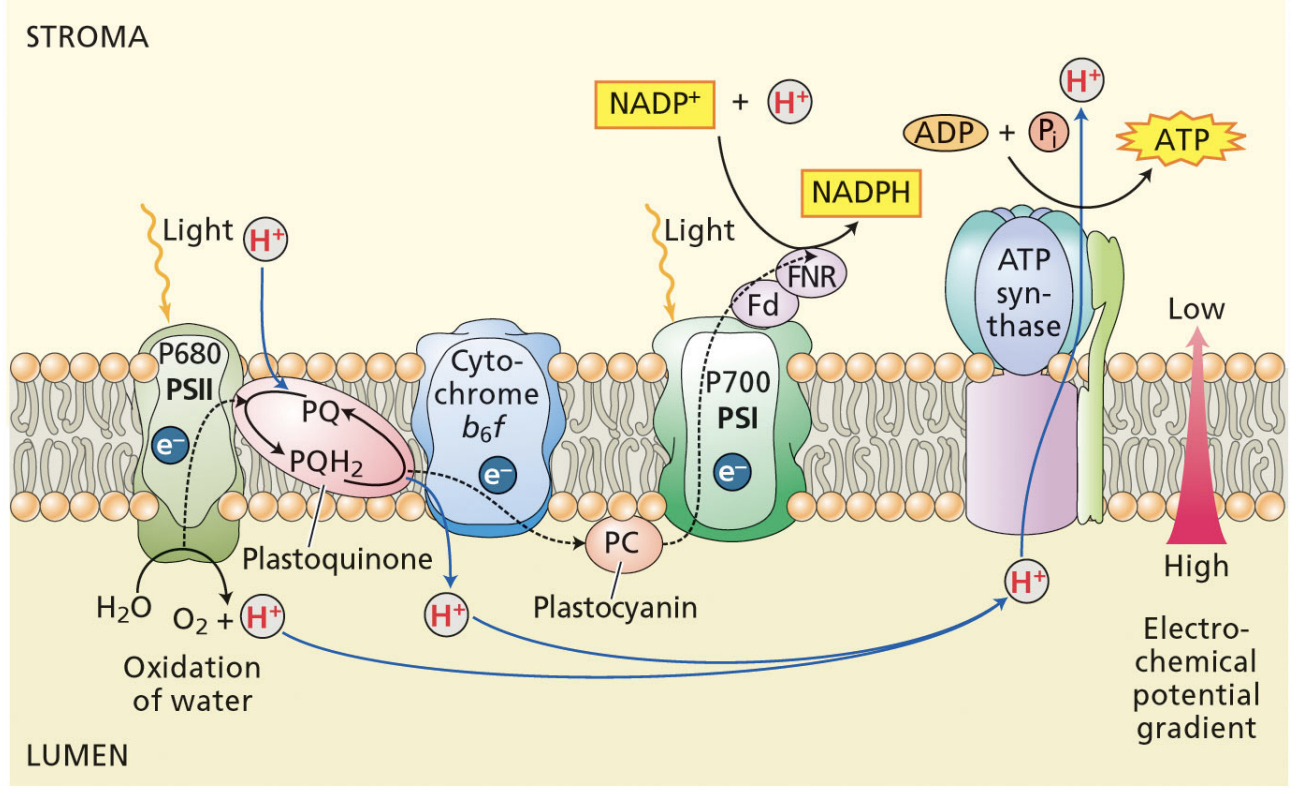
initial electron donor of PSII
H2O
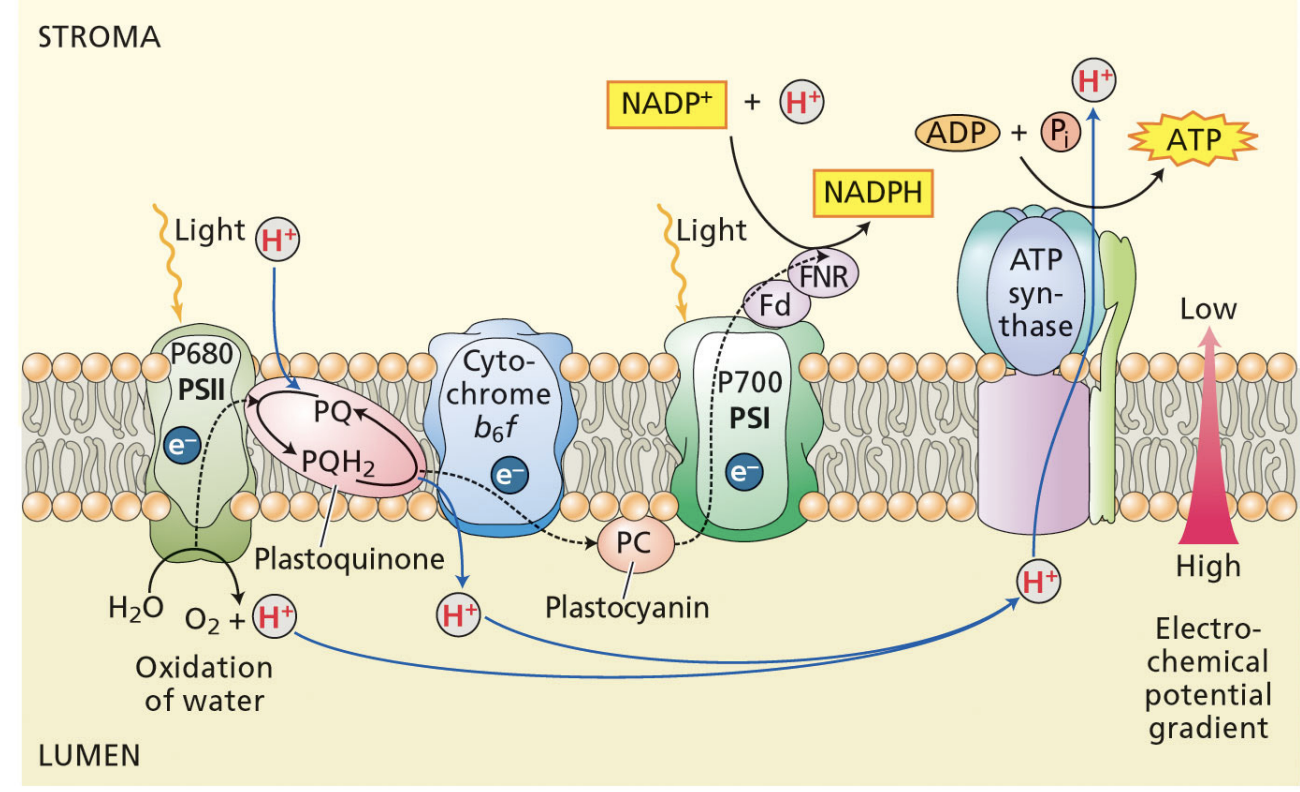
initial electron donor of PSI
plastocyanin
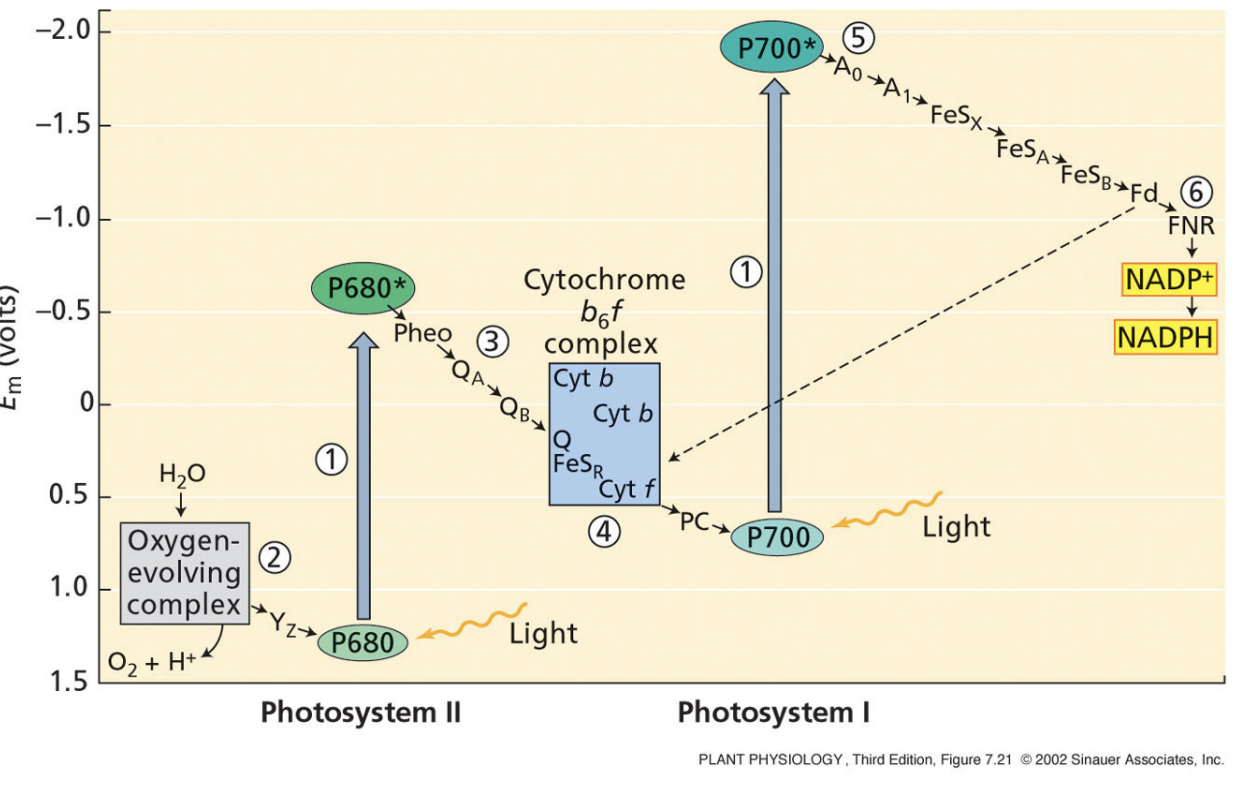
where is PSI and ATP synthase?
stromal thylakoids
unstacked regions
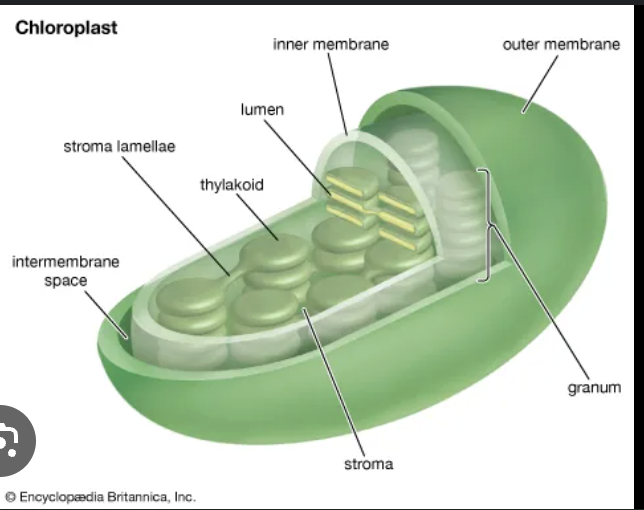
PSI
light oxidizes P700
plastocyanin reduces P700
P700 reduces A0 quinone
A0 quinones transfers electrons through a series of FeS proteins
FeSB reduces soluble ferredoxin
reduced ferredoxin transfers electrons to FNR
FNR reduces NADP+ to NADPH → removes protons from the stroma
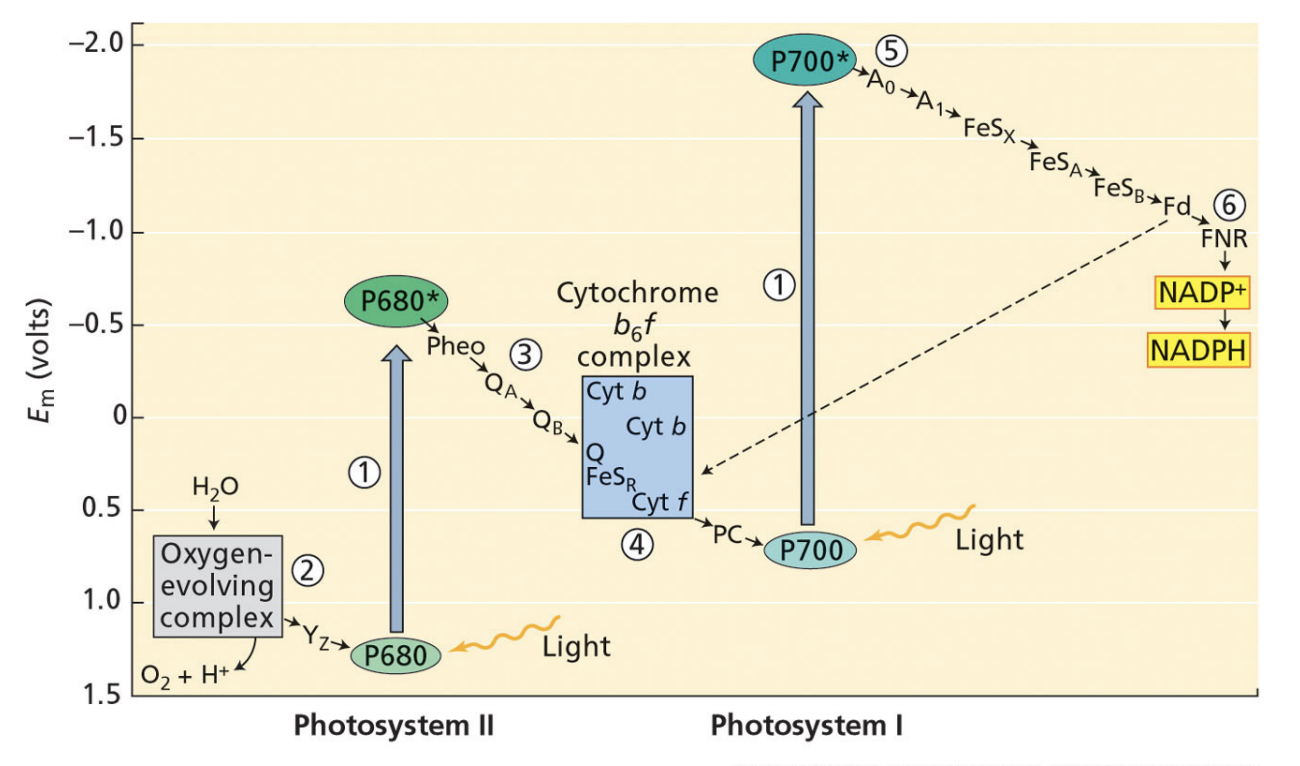
what are the products of the light reactions?
O2
NADPH → used in the Calvin cycle to reduce CO2
ATP
ultimate electron donor for the light reactions?
H2O
ultimate electron acceptor for the light reactions?
NADP+
how does the ATP synthase use the proton gradient to make ATP?
proton concentration is much higher in the thylakoid lumen than in the stroma
protons move down their gradient from thylakoid lumen to the stroma through a channel in the ATP synthase
proton motive force powers the phosphorylation of ADP into ATP in the stroma
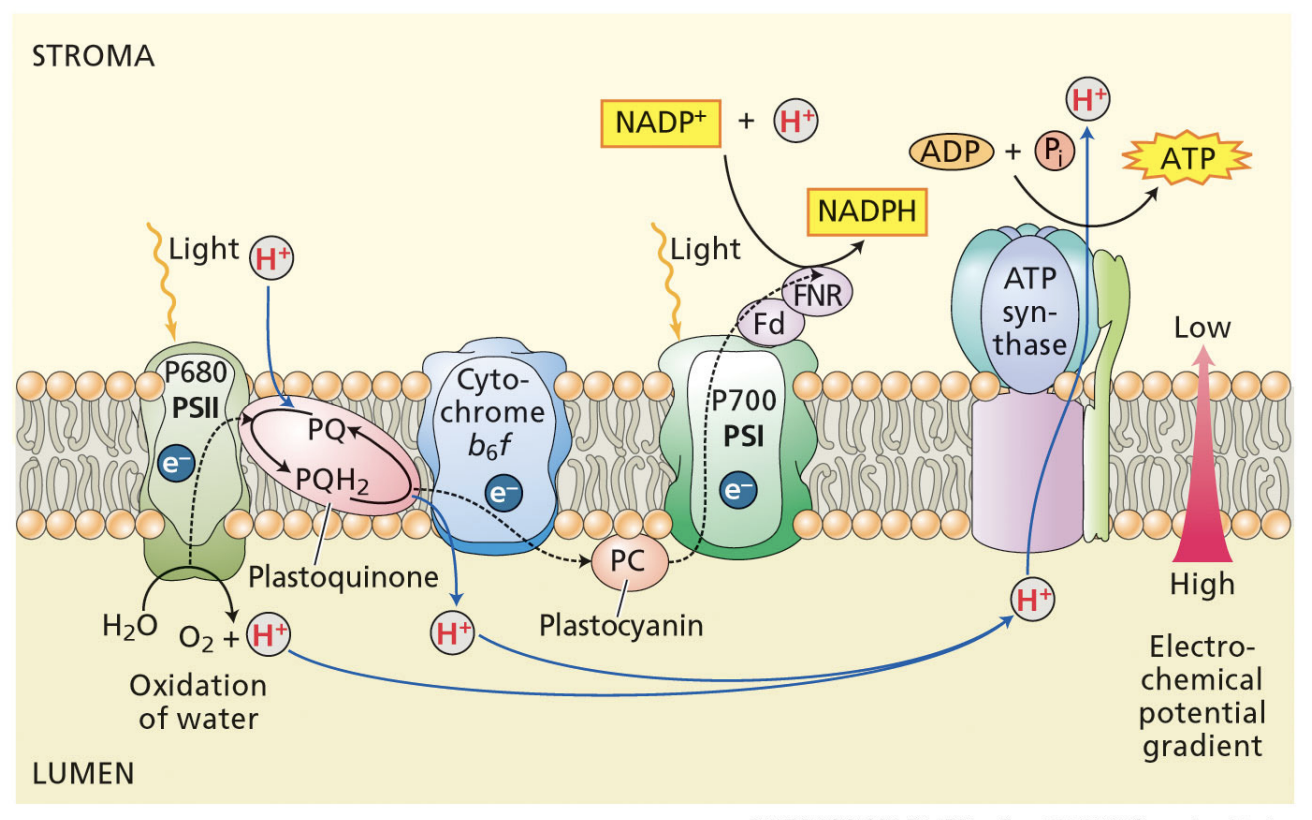
important features of thylakoid structure
continuous thylakoid lumen
extensive contact and continuity between stromal and thylakoid membranes
what ion is required for the splitting of H2O in PSII?
need 4 Mn ions
what does FNR stand for?
ferredoxin NADPH reductase
FNR reduces NADP+ to NADPH → removes proton from stroma and gives NADP+ electrons
what is cyclic electron transport?
chloroplast can redirect electrons from ferredoxin to cyt b6f to make more ATP rather than making more NADPH
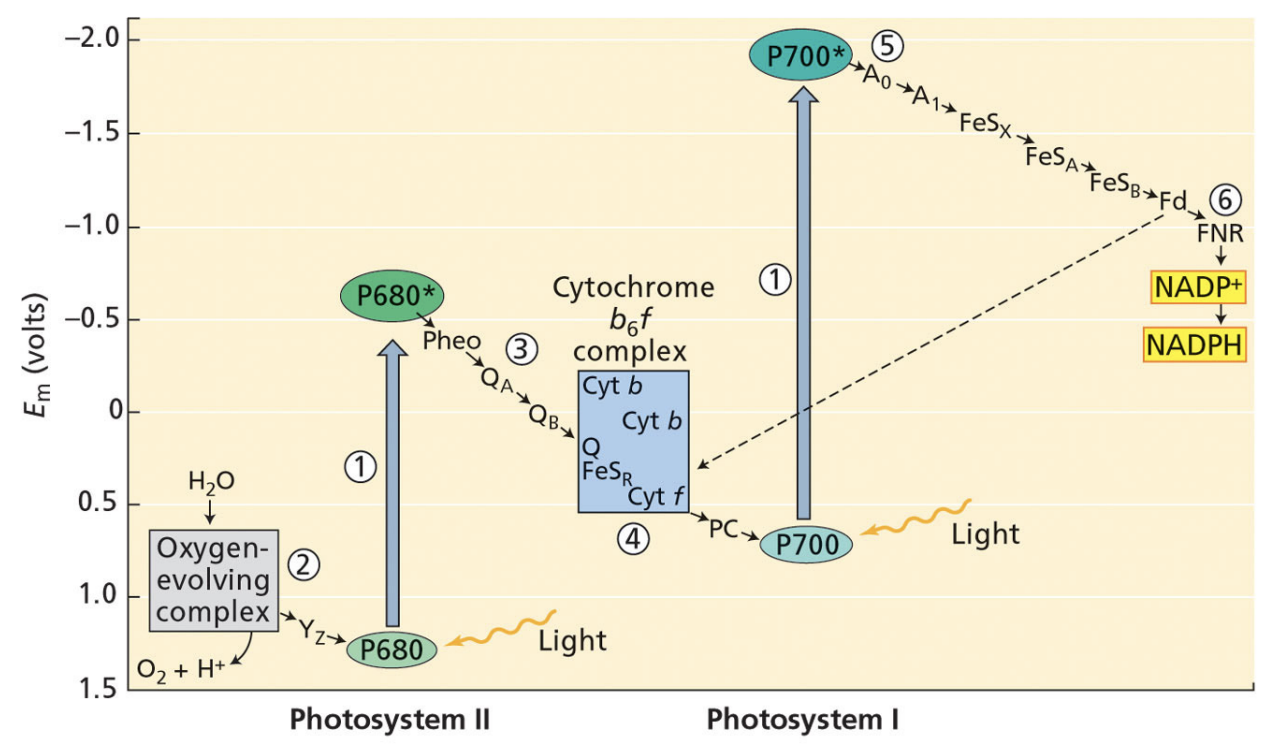
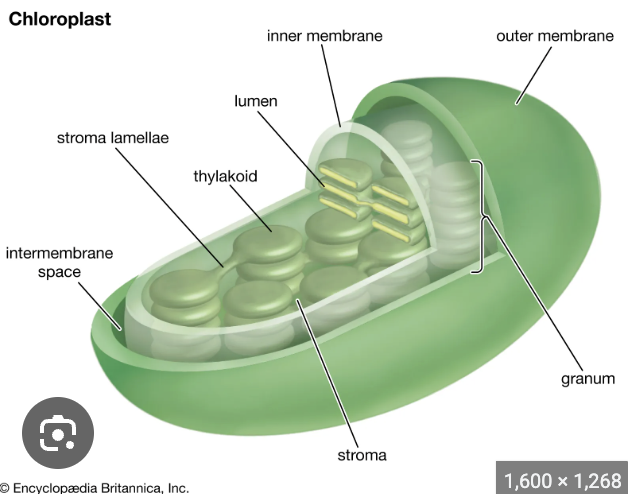
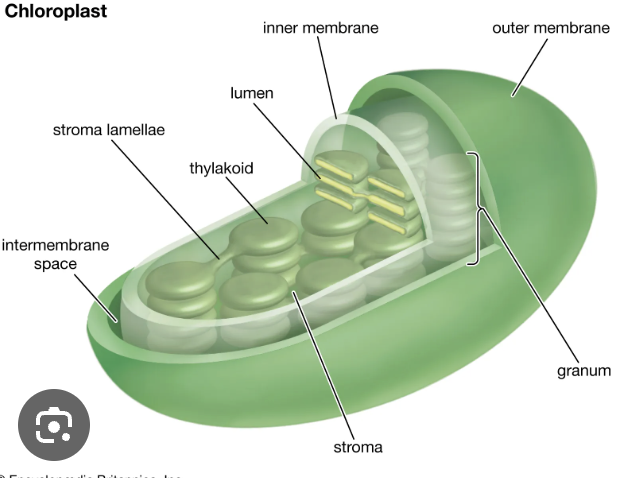
function of the light reactions of photosynthesis
generate ATP and NADPH
function of the carbon reactions of photosynthesis
fix CO2 and regenerate ribulose-1,5-bisphosphate
requires NADPH and ATP
light reactions occur on ______________
thylakoid membrane
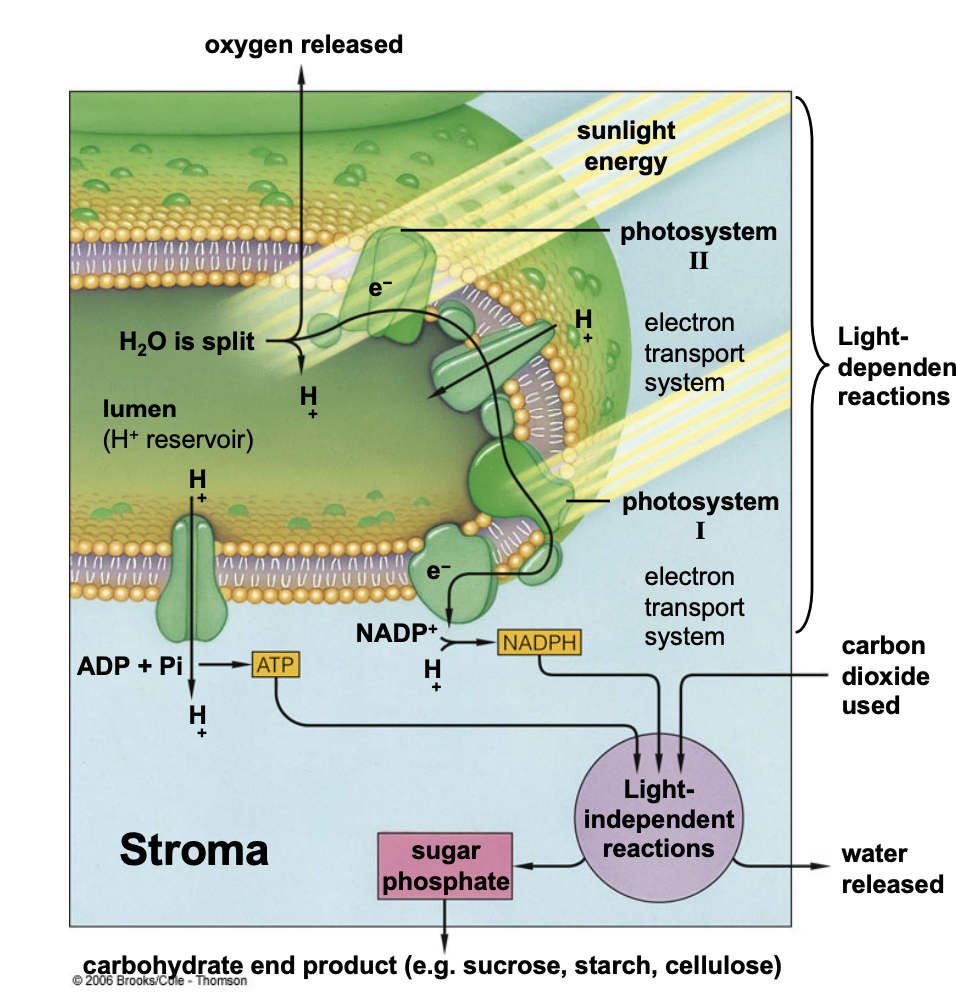
carbon reactions occur in the _________
stroma

NADP+ is reduced to NADPH during __________ in the ___________
PSI
stroma
what is FNR?
protein in the stroma
exists as either a soluble monomer (inactive) or a thylakoid bound dimer (active)
NOT A TRANSMEMBRANE PROTEIN
contains a FAD cofactor → uses reducing power of two ferredoxin to reduce NADP+ → NADPH